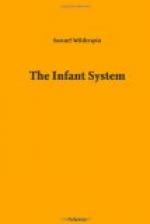[Footnote A: This circumstance took place in the heart of London, and some of the chief actors in it are now men and women; and should this meet the eye of any of them, I am sure they will not forget the circumstances, nor entirely forget their old teacher.]
NATURAL HISTORY.
When teachers are conversing with their children, they should always take care to watch their countenances, and the moment they appear tired, to stop. An hour’s instruction when the children’s minds and hearts are engaged, is better than many hours effort, when they are thinking of something else. In addition to thirty-four pictures of Scripture history, we have sixty of natural history, each picture having a variety of quadrupeds, birds, fishes, and flowers. The first thing we do is to teach the children the names of the different things; then to distinguish them by their forms; and, lastly, they are questioned on them as follows: If the animal is a horse, we put the pointer to it, and say—
What is this? A. A picture of a horse. Q. What is the use of the horse? A. To draw carts, coaches, waggons, drays, fire-engines, caravans, the plough and harrow, boats on the canal, and any thing that their masters want them. Q. Will they carry as well as draw? A. Yes, they will carry a lady or gentleman on their backs, a sack of corn, or paniers, or even little children, but they must not hit them hard, if they do, they will fall off their backs; besides, it is very cruel to beat them. Q. What is the difference between carrying and drawing? A. To carry is when they have the whole weight on their backs, but to draw is when they pull any thing along. Q. Is there any difference between those horses that carry, and those horses that draw? A. Yes; the horses that draw carts, drays, coal-waggons, stage waggons, and other heavy things, are stouter and much larger, and stronger than those that carry on the saddle, and are called draught horses. Q. Where do the draught horses come from? A. The largest comes from Leicestershire, and some come from Suffolk, which are very strong, and are called Suffolk punches. Q. Where do the best saddle-horses come from? A. They came at first from Arabia, the place in which the camel is so useful; but now it is considered that those are as good which are bred in England? Q. What do they call a horse when he is young? A. A foal, or a young colt. Q. Will he carry or draw while he is young? A. Not until he is taught, which is called breaking of him in. Q. And when he is broke in, is he very, useful? A. Yes; and please, sir, we hope to be more useful when we are properly taught. Q. What do you mean by being properly taught? A. When we have as much trouble taken with us as the horses and dogs have taken with them. Q. Why, you give me a great deal of trouble, and yet I endeavour to teach you. A. Yes, sir, but before Infant Schools were established, little children, like us, were running the streets.[A] Q. But you ought to be good children if you do run the streets. A. Please, sir, there is nobody to tell us how[B], and if the man did not teach the horse, he would not know how to do his work.




